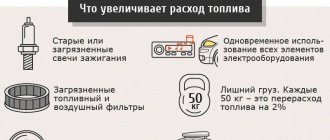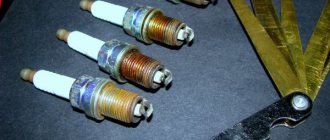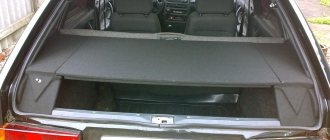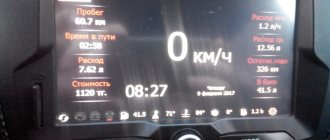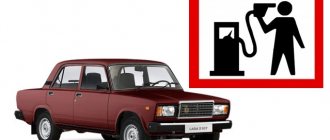Kerosene in the gas tank (do not repeat!)
There is a lot of strange advice on the Internet. For example, one garage specialist recommends adding a mixture of half a liter of kerosene and one hundred milliliters of acetone to the fuel. By pouring it into the gas tank, in return you will supposedly get improved dynamics (due to cleaned injectors), and for some reason fuel consumption should also decrease. According to the author of the advice, his drug surpasses all branded products both in effectiveness and in terms of price/quality ratio. And he also writes this:
Kerosene is used as aviation fuel. But it is not suitable for an engine in its pure form, since it has a high octane number and excessive detonation may occur.
where does dirt come from
Now let’s find out what we will clean our fuel system from, and where the dirt in it comes from if, in fact, we pour clean fuel into the tank. To find out, let's talk a little about fuel. Gasoline, as you know, has an octane number that characterizes the detonation resistance of gasoline, or, to put it simply, it is resistance to self-ignition under compression. An example of this is that if you once drove a Muscovite - 412 and poured 76 gasoline, then after turning off the ignition, the engine still "leaks" intermittently for some time - this is an example of low-octane gasoline. And naturally, knowing this, we pour into our “swallow” at least 92, and preferably 95. But the octane number is the amount of iso-alkanes in the mixture. The standard with an octane number of 100 is isooctane, normal heptane is 0. Therefore, high-quality gasoline contains only iso-alkanes to increase the octane number. This is achieved by catalytic reforming of gasoline. But this process is not cheap. Therefore, to increase octane, they pour into gasoline whatever they can get their hands on, the worst being aromatic hydrocarbons. Toluene is one of them. Its octane is 105, but since it belongs to aromatic hydrocarbons, it is characterized by tarring as a result of its reactions. Also, unsaturated hydrocarbons in fuel lead to the formation of polymers with a low content of molecules in the chain. All this settles in the form of resin throughout the fuel system. We will not discuss what this leads to. This is what we need to wash away.
Acetone in my tank! — logbook Lada 2112 A little tuning of 2007 on DRIVE2
After buying the car, I more than once filled in all sorts of injector cleaners, such as Hi Gear, for the purpose of preventing and cleaning the fuel system of the car, I definitely filled in about 4 of them in total, I thought it helped... as soon as I installed the On-Board Computer www.drive2.ru/l/5638009/ then I began to look at all the parameters and one of the parameters INJECTION TIME, it was 4.3-4.5 ms and even more, and after I filled it with acetone, I was very surprised and began to look at my logs, the very first and the very last before acetone:
Full size
dedicated column
Full size
rightmost column
that is, for the entire period of observation, the time was on average within the range of 4.3-4.5 ms, and then after I filled it with acetone, I was very surprised, the injection time became about 3.8 ms
I poured in a ratio of 100 ml of acetone per 10 liters of gasoline, in this proportion I rolled out 0.5 liters of acetone, well, you can say 0.5 acetone per full tank. At first I thought that due to the admixture of acetone, the injection time became shorter, well, like the fuel became better... then I refueled several times without acetone, burned two tanks of gasoline and the injection time remained at the same level, 3.8 ms. So it turns out that Acetone actually washed the injectors, and the entire fuel system. Right now we need to change the fuel filter and continue to fill it with acetone periodically for preventive maintenance. After that, I started looking for reviews about this liquid: Mixes well with gasoline, mixes completely with water and removes it from the system, dissolves deposits and thereby cleans the fuel system, they also say it increases the octane number of gasoline , the engine runs smoother - I noticed this, it drives better - at the level of self-hypnosis)
Even after the acetone, I changed the receiver from Granta and played with the firmware, configured the XX slightly increased the OZ to XX and reduced the minimum air flow through the IAC, as a result, the air flow became less than 10 kg (previously it was about or more than 12 kg), the injection time was 3.7-3.8 ms, hourly consumption is 0.7-0.8 liters))) now all that remains is to play with the split gear and shift the torque from 3600-3800 to 4500 rpm, if it works out, of course.
What happens if you fill your car with kerosene?
Let's figure out what will happen if instead of gasoline or diesel fuel, you fill your car with kerosene?
Everything has been known for a long time
At the dawn of the development of the automobile industry, when internal combustion engines were simple and unpretentious, and the networks of gas stations were not so developed, motorists “made it up” as best they could. And they poured everything that was at hand into the tank, as long as it would burn.
We also tried kerosene, which was much easier to get than gasoline or diesel. And cars ran quite successfully on such fuel.
Is it possible to replace diesel fuel with kerosene?
Let's start with the fact that diesel fuel has a cetane number of 45-50, and kerosene has a cetane number of 35-40. Thus, by diluting diesel fuel with kerosene, we reduce the total cetane number. Because of this, fuel combustion in the engine deteriorates.
What is the result?
The load on the engine valve system increases,
The overall fuel consumption increases, since the energy intensity of kerosene is lower than that of diesel fuel.
That is: the car will drive, but problems in the future will be serious, and engine overhaul will not be avoided.
And if in a gasoline internal combustion engine?
All of the above are true. There may be less smoke, but a slight detonation will be clearly felt, as if low-quality gasoline was poured into the tank.
In general: the car will also drive, but somewhat worse. The piston system will have a hard time with such fuel, but this is not even the main problem. Once the engine cools down, you simply will not be able to start it again. Kerosene does not ignite if it is cold.
In other words: if kerosene is used instead of gasoline or diesel fuel, then only as an “emergency” means to get to your destination. Driving on such fuel for a long time will not work; car repairs will be expensive.
Source
Why should you pour kerosene into your car’s gas tank every six months?
Diesel drivers will shrug their shoulders: what’s wrong?
Since the time of the Ya-5 “Koju” - the first Soviet heavy fuel truck - drivers have been pouring the brainchild of the Pole Łukasiewicz into their gas tanks. Lily with one sole purpose: to keep the solarium from freezing. The proportions changed over time from 50 to 50 to 1 to 10, but the meaning remained the same: if you add kerosene to diesel fuel, the car will run in any frost. But in a gasoline car. There is one worthy explanation for this fact: domestic gasoline has never been of high quality. According to a long tradition, real miracles begin just outside the Moscow Ring Road and the Ring Road: here even waste from the production of gasoline is turned into gasoline. By pouring explosive liquid, literally and figuratively, into gas tanks, Russians feel a deterioration in dynamics, a drop in power and many other eccentricities of the car. And they immediately begin to fight them.
Those who are richer and more hasty run to stores to buy “magic in a jar”, which will instantly fix all problems, and even smells like strawberries. Those who decide to understand the essence of the problem will turn over the overseas jar and find in the jungle of beautiful words and complex phrases a painfully familiar word: kerosene.
Indeed, kerosene does an excellent job of cleaning injectors and throttle bodies, washing out all the dirt from the fuel system. Those who wish can safely, but ten times cheaper, purchase a bottle of a product that is as old as the world and proven, like ZIK’s axe, and has powerful cleaning abilities. To be completely honest, kerosene does not need any additives - the main thing is that the injectors survive this explosive power.
As always, any miracle has a downside: firstly, there is no need to add kerosene to the gas tank. Doing this every six months is more than enough. Secondly, you need to be especially careful the first – trial – time. The fact is that kerosene will sweep away build-up not only from the injectors and fuel lines, but will also lift up all the dirt that has accumulated in the gas tank for years. And not only will it lift it, it will also send it directly to the holy of holies - to the engine. Who will benefit from this is a big question, so before experimenting with kerosene, you should remove and wash the gas tank. You can use the same means, by the way.
Before using the “grandfather’s” methods, loudly expressed in yet another online community, you need to carefully weigh the consequences: is it worth pouring into a modern, high-tech engine the same thing that was poured into Zhiguli and Moskvich cars in the last century? A bucket could fly whistling through the fuel line and “boilers” of the same “Volga” - no one would have noticed. But a fragile injector of a brand new foreign car, the service life of which the manufacturer himself estimated at three years, may not appreciate this approach. All means are good when they are in moderation.
Regularity of engine cleaning
Experts recommend cleaning the fuel system using aviation kerosene no more often and no less than once a year. This allows you to prevent problems with rare earth coating of engine cylinders, while simultaneously eliminating all possible deposits on the elements of the injection system. This work is best done in the fall before the onset of cold weather, which simultaneously solves problems with water accumulated in the gas tank.
The car owner only needs to understand that the use of kerosene will, first of all, be an excellent preventive measure against the appearance of plaque and contamination on the elements of the fuel system. However, dealing with existing serious pollution in this way will be problematic. Therefore, you should regularly clean the engine using a small amount of aviation kerosene from existing contaminants; only in this case will it be possible to subsequently prevent the occurrence of various types of malfunctions, the elimination of which will require significant financial costs for the car owner.
conclusions
The use of aviation kerosene, which is added to the gas tank, allows you to bind and remove water, as well as cleanse the entire fuel system of existing contaminants and dense deposits. This is a completely safe and effective product that is easy to use. It is recommended to carry out such cleaning on a regular basis annually, which will be an excellent prevention of serious engine malfunctions, while reducing the car owner’s costs for operating and repairing his car.
What is aviation fuel?
Fuel for use in the aviation industry is a flammable substance intended to be supplied mixed with air into the combustion chamber of an aircraft engine. The goal is to obtain thermal energy, which is released at the moment of oxidation of the mixture with oxygen, that is, combustion. The fuel poured into the coffered tanks of aircraft is divided into two types.
Aviation gasoline
This type of fuel is obtained using direct distillation, reforming or catalytic cracking. The main physical and chemical indicators of aviation gasoline are:
- resistance to detonation;
- chemical stability;
- factional composition.
Gasoline is characterized by high volatility and suitability for the formation of fuel-air mixtures necessary for current flight conditions.
This type of combustible mixture is used for combustion in piston internal combustion engines. Airplanes with such engines fly short distances on local airlines and are used for demonstration flights and air shows. The most popular brands in Russian small aviation were the brands of leaded gasoline for normal and lean mixtures, developed in the last quarter of the last century - B91/115 and B95/130. Today, the small aircraft fleet is fully fueled with regular AI-95 gasoline or imported AVGAS 100LL fuel.
Interesting: How is the lawn on a football field made striped?
Aviation kerosene
Regular gasoline is not suitable for combustion in the combustion chamber of a turbojet aircraft engine. Piston engines use the effect of sudden ignition of the gasoline-air mixture to create a shock at the cylinder head. A completely different principle is used in jet engines
It is important here that the combustion is smooth. This is exactly what burning aviation kerosene provides
To fill the caissons of jet aircraft, fuel is used, which is obtained from the middle distillate kerosene fraction of oil with a boiling point of 150-280°C. 96-98% of the composition of aviation kerosene is naphthenic, paraffin and aromatic hydrocarbons. The rest of the composition comes from resins, nitrogenous and organometallic compounds.
How to make 76 gasoline from 92
So, we decided that we will dilute 92 gasoline with kerosene. The calculator below will help you calculate exactly how much gasoline and kerosene need to be mixed to obtain the required volume of 76 gasoline.
For this calculation, a formula is used that can also be used for diluting gasoline with a petroleum product with a different volume fraction of octane.
Suppose we have gasoline with a volume fraction of octane A, and we need to get B. We also have kerosene with an octane number of 45, let’s calculate the proportion:
We need to take (AB)/(A-45) parts of kerosene, let's take this as the number K
Then you need to add (1-K) parts of gasoline to this amount.
We multiply K by the amount of fuel required and get the volume of how much kerosene needs to be taken.
Similarly, multiplying (1-K) by the amount of the final petroleum product, we get how much initial fuel needs to be taken.

